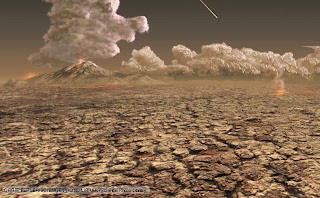For five million years after the worst mass extinction in Earth history, much of the planet was simply too hot for anything to survive, scientists have learned.
Experts have long been puzzled by the 'broken world' scenario that followed the Permian-Triassic mass extinction 250 million years ago.
Up to 96% of all marine species and 70% of land-dwelling vertebrates were wiped out by the event, thought to have been caused by a combination of climate change and volcanic activity.
Typically it takes tens of thousands of years for new species to appear after a mass extinction.
But in the case of the Permian-Triassic event, this 'dead zone' lasted an extraordinary five million years.
A new study has now indicated why.
Temperatures in the tropics rose to lethal levels, soaring to 60C on land and 40C in the sea, and prevented life re-emerging.
'Global warming has long been linked to the end-Permian mass extinction, but this study is the first to show extreme temperatures kept life from restarting in equatorial latitudes for millions of years,' said lead researcher Yadong Sun.
During the long heatwave no forests grew in the tropics, only shrubs and ferns, and shellfish were the only marine creatures in the oceans.
Virtually no land animals existed because their metabolisms would not have withstood such high temperatures.
Only the polar regions offered a habitable refuge from the baking heat.
Normally plants help regulate temperature by absorbing carbon dioxide and sealing it away in vegetable matter.
The scientists collected data from 15,000 conodonts - tiny teeth from extinct eel-like fishes - from rocks in southern China.
By studying oxygen atoms in the conodonts, they were able to calculate temperature levels many millions of years ago.
Professor Paul Wignall, from the University of Leeds School of Earth and the Environment, said: 'Nobody has ever dared say that past climates attained these levels of heat.
'Hopefully future global warming won’t get anywhere near temperatures of 250 million years ago, but if it does we have shown that it may take millions of years to recover.'




0 comments:
Post a Comment